
|  |
Disney Goes Hawaiian, Part 2:
What not to Expect from
Disney at Ko Olina
|
A SIDE TRIP FROM

|
Last week, I wrote What to Expect from the Disney Resort at Ko Olina,
discussing the resort that Disney announced for the Hawaiian island of O‘ahu.
There’s also something you shouldn’t expect—despite what you might have read on the Internet.
|
 , Curator of Yesterland, October 10, 2008 , Curator of Yesterland, October 10, 2008

|
|
After two big announcements from Disney in 2007, the Internet was abuzz with the conclusion that Disney Cruise Line was likely to base a cruise ship in Hawai‘i beginning in 2011 or 2012.
But just because something seems to make a lot of sense on the surface doesn’t mean it will happen.
Let’s start by looking at five pieces of evidence, and see what the logical conclusion would be.
|
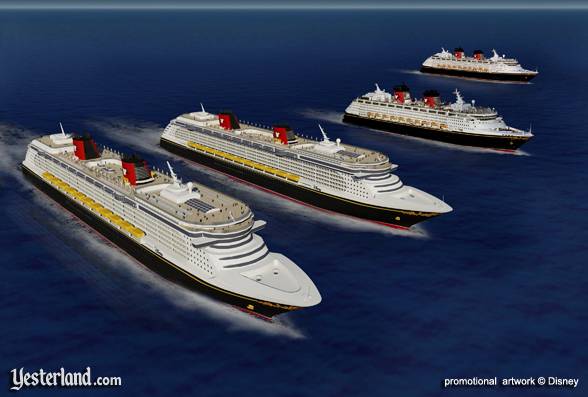
1. Disney announced that two new ships would
bring the Disney Cruise Line fleet to four.
|
|
On April 23, 2007, Disney Cruise Line announced a contract with Meyer Werft in Germany to build two 124,000-ton ships.
The new ships are scheduled to launch in 2011 and 2012.
They’ll join the two current 83,000-ton ships, the Disney Magic and the Disney Wonder, bringing Disney’s fleet to four ships.
If Disney follows the usual pattern in the cruise business, the new, larger ships will take over the proven, popular itineraries—providing the twin advantages something new to entice repeat passengers and more capacity to handle them.
That would mean the larger Disney ships would operate out of Port Canaveral in Florida, while the two current ships would go to new home ports.
For example, one could go to Europe, and the other could go to the Pacific Ocean.
|
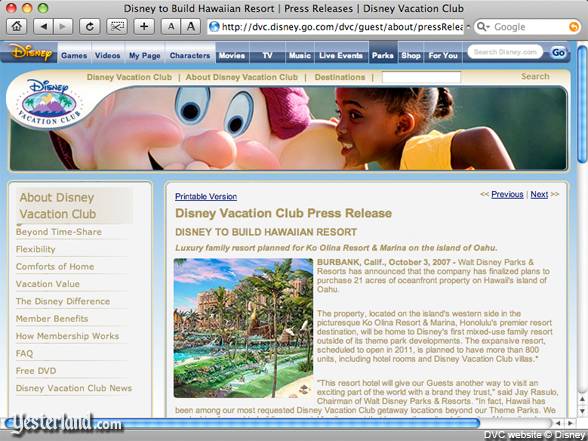
2. Disney announced a Disney Vacation Club
and deluxe resort for Ko Olina on O‘ahu.
|
|
Less than a half year after the new ships were announced, Disney made another blockbuster announcement.
On a 21-acre parcel facing the largest lagoon at O‘ahu’s Ko Olina Resort, Disney would build an 800-unit resort with hotel rooms and Disney Vacation Club villas.
The scheduled opening would be 2011—just like the launch of the first of the two new cruise ships.
Although the Disney parcel is too small for a theme park, the promotional artwork promised a spectacular tropical destination.
For more details, including the artwork and press release, see What to Expect at the Disney Resort Ko Olina.
With this one major project, Disney would go from a company with no real presence in Hawai‘i (except for a Disney Store at Ala Moana Center) to operating one the biggest resorts in the whole state.
And with Disney’s reputation of catering to families, this Disney resort promises to be the number one choice for families planning vacations to the “Aloha State” with children.
|
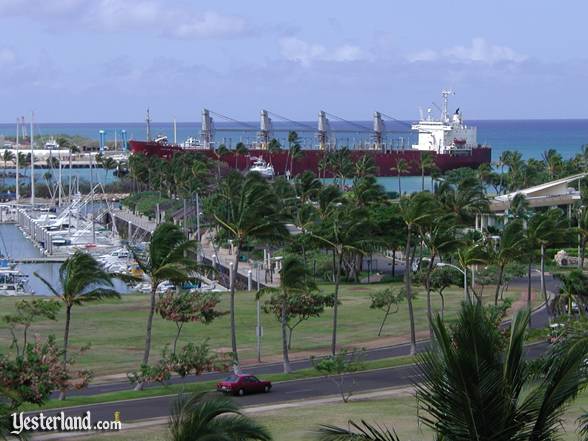
3. There’s a harbor capable of handling large
ships just beyond the Ko Olina Marina.
|
|
For the new resort, Disney chose a location that’s only about a mile from one of Hawai‘i’s major ports.
Kalaeloa Harbor, formerly named Barbers Point Harbor, is the second busiest commercial harbor in Hawai‘i.
Much of the harbor is still undeveloped.
In 2003, there was a proposal to add a pier which would allow 900-foot cruise ships to call at Kalaeloa Harbor, but the plan never moved forward because of the lack of a commitment from a cruise line at that time.
Presumably, a long-term financial commitment from a cruise line, similar to Disney’s commitment at Port Canaveral, would result in appropriate facilities to support cruise operations out of Kalaeloa.
Disney’s cruise ships have been called theme parks at sea.
It’s easy to imagine a vacation that combines a stay at a magnificent oceanfront resort with an equally magnificent cruise to other islands from a port that’s only a mile away.
|
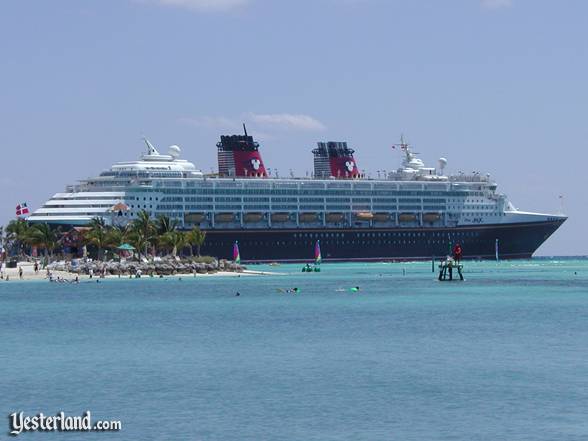
4. Disney Cruise Line surveys suggest that
Hawai‘i is a potential cruise itinerary.
|
|
Disney Cruise Line conducts surveys when passengers complete their cruises.
For several years now, the survey has asked passengers to identify where else they would like to sail with Disney—chosen from a short list that includes Hawai‘i.
The Caribbean cruise market is fiercely competitive.
Disney Cruise Line charges more than the competition for similar cruises. This means that price-sensitive customers routinely choose less expensive alternatives, which ultimately limits what Disney can charge.
|
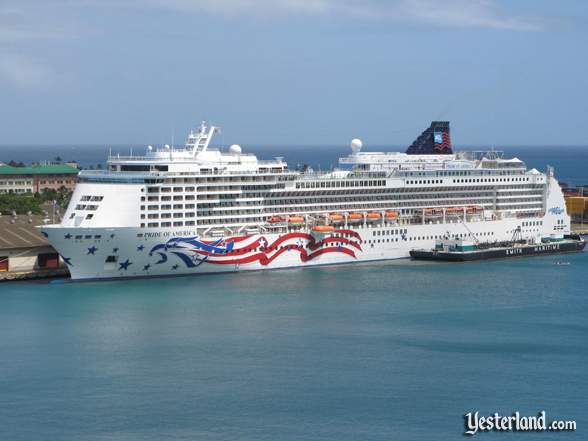
5. Only one cruise line, NCL, currently offers
itineraries entirely within the Hawaiian Islands.
|
|
It’s a different story in Hawai‘i than in the Caribbean.
Only NCL, which is short for Norwegian Cruise Line, offers itineraries that remain in the waters and ports of Hawai‘i.
Each of Hawai‘i’s four main islands offers something unique, so it’s great to be able to visit all of them from the convenience of cruise ship.
Other cruise lines operate occasional Hawai‘i cruises from West Coast ports such as Los Angeles and Vancouver, but such cruises are typically 14 or 15 nights long and involve four full days at sea in each direction.
Most families lack the vacation time and financial resources for such long cruises, so these cruises tend to attract well-heeled retirees.
1, 2, 3, 4, 5!
With the five pieces of evidence above, it’s easy to understand why some Disney-oriented bloggers, website columnists, podcasters, and discussion board participants reached the very logical conclusion that Disney land-and-sea vacations could be coming to Ko Olina.
It sounds good, but it’s not going to happen.
Let’s look at five more pieces of evidence to see why not.
|
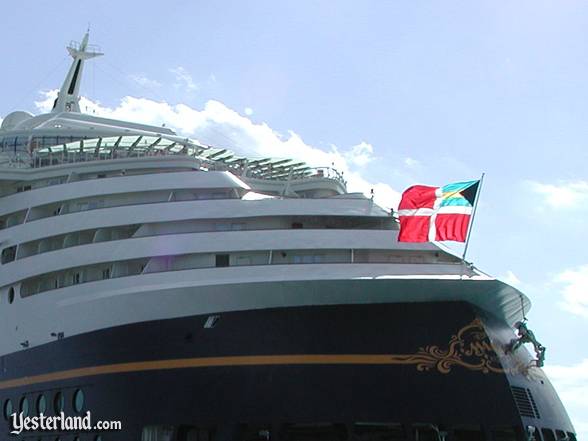
1. The ships of Disney Cruise Line are foreign-
registered, not American-registered.
|
|
Although The Walt Disney Company is a U.S.-based company, Disney’s cruise ships are registered in The Bahamas.
With just one exception—which I’m getting to—all large cruise ships operating out of U.S. ports are registered outside of the United states, usually in The Bahamas (Nassau), Panama, or Liberia (Monrovia).
Through foreign registration, the cruise lines—including Disney—are able to operate foreign-built, internationally-crewed ships without U.S. labor laws.
The ships’ foreign registrations are “flags of convenience.”
In most cases, the ships never even call on the countries to which they’re registered.
In this regard, Disney is an exception; the Disney Wonder regularly calls on Nassau in The Bahamas, and both Disney ships call on Disney’s private island, Castaway Cay, which is one of the many islands of The Bahamas.
While foreign registration allows cruise lines to operate outside of U.S. labor laws, it also imposes restrictions due to a United States law from way back in 1886—the Passenger Vessel Services Act or PVSA.
It’s sometimes mistakenly referred to as the Jones Act.
(The PVSA applies specifically to passenger ships, while the Jones Act deals with cargo between U.S. ports and sailors’ rights.)
|
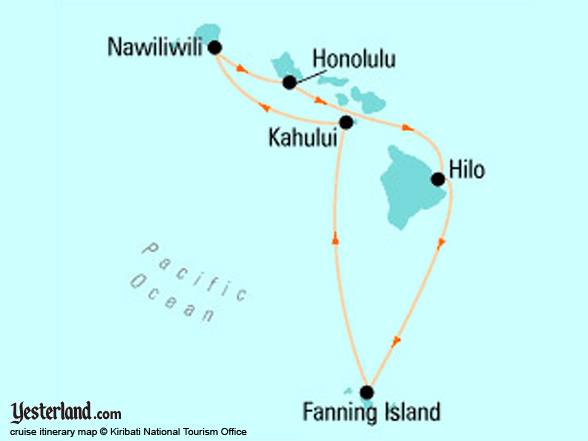
2. Foreign-flagged ships cannot operate entirely
between U.S. ports because of the PVSA.
|
|
The PVSA requires foreign-flagged ships to call on at least one foreign port when operating out of a U.S. port.
That’s easy to do in the Caribbean.
It’s also easy for Alaska cruises, which either originate in Canada or call on at least one Canadian port.
But calling on a foreign port is hard to do for a ship based in Hawai‘i.
If you look at the map above, you’ll see how NCL tried to deal with the PVSA when they used the Bahamian-flagged Norwegian Star for 7-night “Hawai‘i” cruises back in 2002.
NCL looked for the closest foreign destination.
They found Fanning Island, a tiny atoll with a population of about 2500, governed by the Republic of Kiribati.
On the map, Fanning Island appears to be quite close to Hawai‘i—the distance from Hilo on the Big Island to Fanning Island seems to be less than the distance to Nawiliwili Harbor on Kaua‘i.
There’s no disclaimer, “this map is not to scale,” but there should be.
Fanning Island is actually around a thousand nautical miles from Honolulu.
The Norwegian Star spent from 2 p.m. on Monday until 1:00 p.m. on Friday sailing to Fanning Island, spending just six hours there, and sailing back to Hawai‘i. The run to and from Fanning Island chewed up most of the week, leaving very little time in Hawai‘i.
|
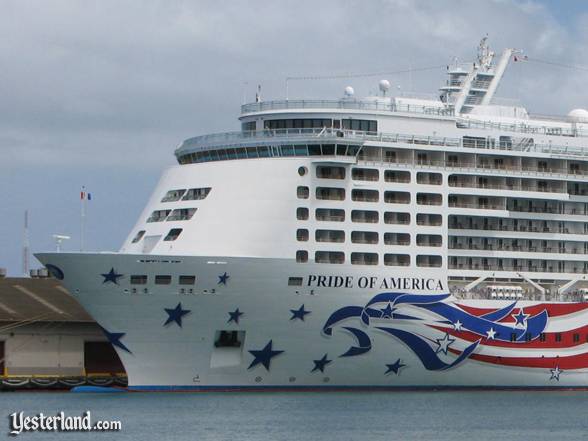
3. There is only a single large U.S.-flagged cruise ship
operating today, the NCL Pride of America.
|
|
Launched in 2005, NCL’s Pride of America is the only cruise ship operating cruises solely within the Hawaiian Islands.
There’s no “flag of convenience” here.
NCL calls the Pride of America the “first new U.S.-flagged cruise ship in nearly 50 years.”
Construction on the Pride of America began as part of the failed attempt by now-defunct American Classic Voyages Inc. to have Litton-Ingalls Shipyard in Mississippi build two cruise ships in the United States—the first American-built cruise ships since the S.S. Brasil and S.S. Argentina in 1958.
After American Classic Voyages folded and the ship construction floundered,
NCL bought the hull and had it towed to the German Lloyd Werft shipyard for completion.
None of the other current cruise lines have gotten into the U.S.-flagged cruise business, presumably because they can make more money with foreign-flagged ships.
|
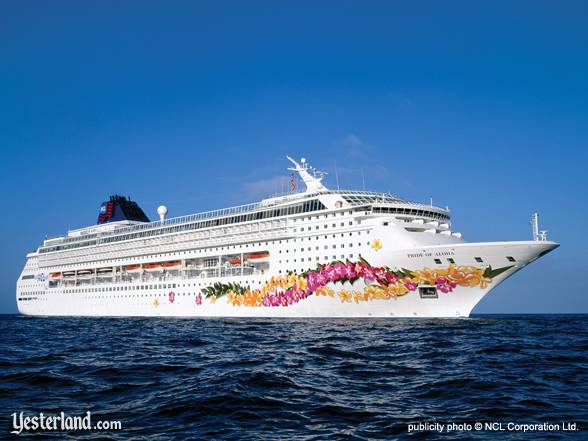
4. NCL lost a bundle on NCL America, and
reflagged two NCL America ships.
|
|
NCL tried to launch a new brand, NCL America, with a fleet of U.S.-flagged ships.
Somehow, NCL was able to get legislation passed to operate foreign-built vessels under the U.S. flag, but they still had to comply with U.S. labor and maritime laws.
The Norwegian Sky, originally built in Germany in 1999, became the Pride of Aloha in 2004.
The partially American-built Pride of America joined the fleet in 2005.
Another new ship, the German-built Pride of Hawai‘i, brought the NCL America fleet size to three in 2006.
NCL America got off to a poor start.
When the Pride of Aloha entered service, passengers complained about dirty staterooms, poor upkeep overall, and lousy food—if they could even get served.
NCL had underestimated the difficulty of hiring, training, and keeping American crew members who would provide the same level of service as the excellent foreign crews on other cruise ships.
Hundreds of crew members quit during the maiden cruise.
It’s not that Americans aren’t capable of providing excellent service.
A vacation at Disneyland or Walt Disney World is ample proof of that.
But Americans who want to work in jobs serving the public can find decent jobs that don’t require them to endure the conditions on cruise ships.
NCL America figured out ways to improve service.
But the real problem was that the cruises in Hawai‘i were losing money—lots of money.
For 2006, NCL Corporation Ltd. reported a net loss of $130.9 million on total revenues of $2.0 billion.
According to the NCL press release with its 2007 financial results,
“The increase in payroll and related expenses was principally attributable to the high crew costs associated with U.S. crew in our inter-island Hawai‘i cruises.”
To make matters worse, NCL found themselves with far more competition than they expected from cruise lines calling on Hawai‘i with foreign-flagged ships operating from the mainland.
For 2007, NCL’s net loss increased to $227.0 million.
(Fuel costs, interest rates, and the weak dollar also contributed to the NCL’s loss.)
NCL responded by downsizing the NCL America fleet to a single ship, the Pride of America.
In the first half of 2008, the Pride of Aloha once again became the Bahamian-flagged Norwegian Sky, and the Pride of Hawai‘i became the Bahamian-flagged Norwegian Jade.
The Sky sails out of Miami, and the Jade sails out of European ports.
It is unlikely that any other cruise line will try to enter the Hawaiian inter-island cruise business with a U.S.-flagged ship after NCL’s experience.
|
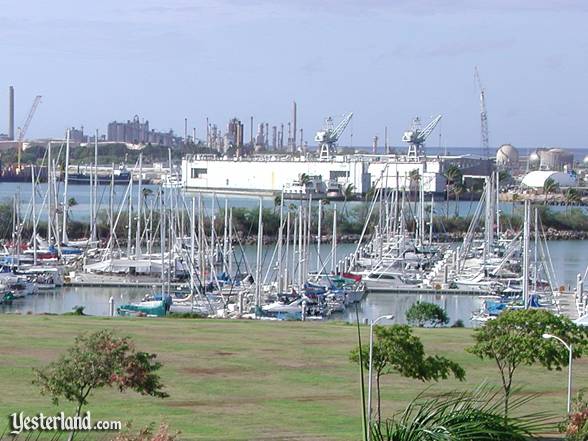
5. Kalaeloa Harbor does not have a
cruise terminal or a cruise dock.
|
|
We shouldn’t expect a Disney ship to operate roundtrips out of Kalaeloa Harbor.
But that doesn’t mean that Disney Cruise Line will never offer any sailings that involve Hawai‘i.
After all, in 2010 Disney is offering 12-night Northern European cruises out of Dover, England with port calls such as Stockholm, Sweden, and St. Petersburg, Russia.
So Disney could offer 14-night cruises to Hawai‘i from Los Angles; all it takes is a brief stop at Ensenada, Mexico, to comply with the PVSA.
It might be a good option for a West Coast-based Disney ship, in addition to Alaska and the Mexican Riviera.
Does this mean that we should expect the Disney Wonder or Disney Magic sailing into Kalaeloa Harbor?
Will the passengers be able to use the facilities at Disney’s resort in Ko Olina as a Castaway-Cay-of-the-Pacific?
I’m afraid the answer is “no” to both questions.
Unless the Hawai‘i Department of Transportation takes an “if you build it, they will come” approach to a cruise terminal at Kalaeloa Harbor, there will be no place there for cruise ships to dock.
No cruise line wants to commit to long-term and frequent operations there.
Honolulu Harbor can handle the Pride of America and the cruise ships from West Coast, so there’s not a strong business case to add facilities at Kalaeloa Harbor.
Also, consider that the recreational facilities—pools, whirlpools, water slide, lounge chairs—at the Disney resort at Ko Olina will be designed to serve the guests who will occupy the 800 units.
Now imagine what would happen if 2400 passengers from a Disney Cruise ship would occasionally compete for those facilities.
Yes, you may see a Disney cruise ship in Hawai‘i.
But, if so, you’ll probably see her at Honolulu, Nawilwili, Kahului, and Hilo—not at Kalaeloa Harbor by Ko Olina.
That leaves one more question... Why did Disney pick a site so close to a harbor if the plan wasn’t to take advantage of this proximity?
The answer is that Disney didn’t have much choice.
Disney chose the best location available in Hawai‘i these days.
There aren’t large tracts of beachfront land with “for sale” signs in Hawai‘i.
The master-planned resort developments on other islands, such as Kaanapali and Wailea on Maui, are fully built out.
Ko Olina had undeveloped building sites, and they’re nice and large ones like Disney’s 21-acre parcel.
The reason that there’s a master-planned resort at Ko Olina is that it’s a genuinely great resort location in terms of weather, sunsets, O‘ahu’s wide selection of attractions, and terrific (manmade) beaches.
Note:
This article is based on research using publicly available information and on personal experience at Ko Olina.
I have no inside information from Disney Vacation Club, Disney Cruise Line, any other company, or any government agency.
The statements about the future are predictions based on this research and experience.
The actual future may turn out differently. — Werner Weiss
|
© 2008 Werner Weiss — Disclaimers, Copyright, and Trademarks
Updated December 10, 2009.
Disney Cruise Line artwork: © Disney
Disney Vacation Club website: © Disney
Photo of ship entering Kalaeloa Harbor: Werner Weiss, 2005
Photo of Disney Magic at Castaway Cay: Werner Weiss, 2005
Photo of Pride of America in Honolulu Harbor: Werner Weiss, 2007
Photo of Bahamian flog on the Disney Magic: Werner Weiss, 2005
Fanning Island cruise itinerary map: © Kiribati National Tourist Office
Photo of bow of Pride of America: Werner Weiss, 2007
Publicity photo of Pride of Aloha: © NCL Corporation Ltd.
Photo of Ko Olina Marina and Kalaeloa Harbor: Werner Weiss, 2005
|
|